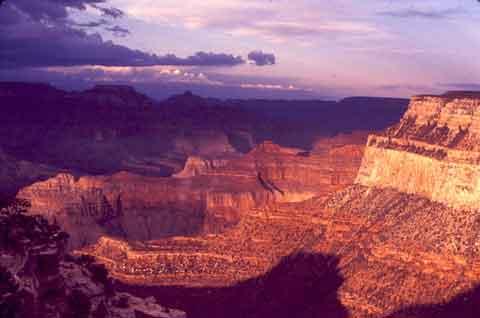For the next month or two, visitors to Grand Canyon National Park may notice that drinking water coming from the taps in the park looks a bit "cloudy." Is the water safe to drink? The park recently supplied the answer—and an explanation.
Cloudy tap water is a common springtime occurrence at the park and other locations around the country. Here's why. According to the park,
Each year in the spring (April – June), an increase in the turbidity of drinking (potable) water occurs at Grand Canyon National Park. This ... is caused by snow melt and the spring rains recharging the aquifer, and the increased water flows through the rock formations to the point of supply for the Grand Canyon National Park Public Water Supply System.
As water flows through these rock formations, very small particles of inorganic material are dissolved from the rock and are held in suspension in the water. This ... material is too small to be removed by the centrifugal separation process used at Roaring Springs and remains in the potable water.
These particles of dissolved rock and minerals appear in the potable water as a slight tint or a noticeable cloudiness. The extent of the turbidity is directly proportional to the amount of snowmelt and rainwater that flows through the rock formations.
This annual event has been exhaustively researched and evaluated for the past fifteen years by the National Park Service, independent laboratories, the U.S. Public Health Service, and the Arizona Department of Environmental Quality....
Although this dissolved inorganic material causes the water to be slightly cloudy, the dissolved material is well below maximum contaminate levels established by the Environmental Protection Agency and is not harmful to health.
Even so, the park is taking extra precautions.
Turbidity has no health effects but can interfere with the disinfection processes ...and may provide a medium for microbial growth. For those reasons, we routinely increase the chlorine residual of the drinking water and increase our microbiological water sampling and testing throughout this spring period of increased turbidity to insure that the drinking water is adequately disinfected.
The increased chlorine dosage and the enhanced microbiological monitoring and testing is maintained until the turbidity drops to the normal values ... usually by late June or early July.
In short, that partly cloudy appearance visitors to the park may notice in the tap water for the next couple of months may be an aesthetic problem for some people—but it's not a health risk. If you want more details on the subject, the park has posted the required "public notice" on-line.
One related issue if you're visiting the Grand Canyon or any other locations with an arid climate: be sure to drink adequate amounts of water or other suitable fluids. Dehydration is a real problem in dry climates, but visitors from other areas are often simply unaware of how quickly their bodies can lose water when the humidity is low, even if the temperature is relatively pleasant. When that happens, you just won't feel very well, and if the situation continues, you can become seriously dehydrated and require medical attention.
The problem of inadequate fluid intake is especially critical for hikers as the weather warms up at the Grand Canyon, and elsewhere. The park's website has some excellent tips for warm weather hiking that would apply to any strenuous activity in a warm, dry climate.
So... don't let a little tinge in the tap water create a bigger problem that can spoil your trip. If the color in the water makes you leery, the park suggests you buy some bottled water. Either way...have a drink of water and enjoy your visit to the park!


 Support Essential Coverage of Essential Places
Support Essential Coverage of Essential Places







Comments
On another post they were talking about uranium mining in the Grand canyon. Someone said uranium mining would not damage any water in the area. They wanted to know how many farm is actually get water supplied by the Grand canyon. Someone give me an answer to tell them. Could the uranium mining pollute the water and how many farms would actually be hurt if the water did become polluted?
Its a National Park and protected land there is no mining allowed, the information you have is false